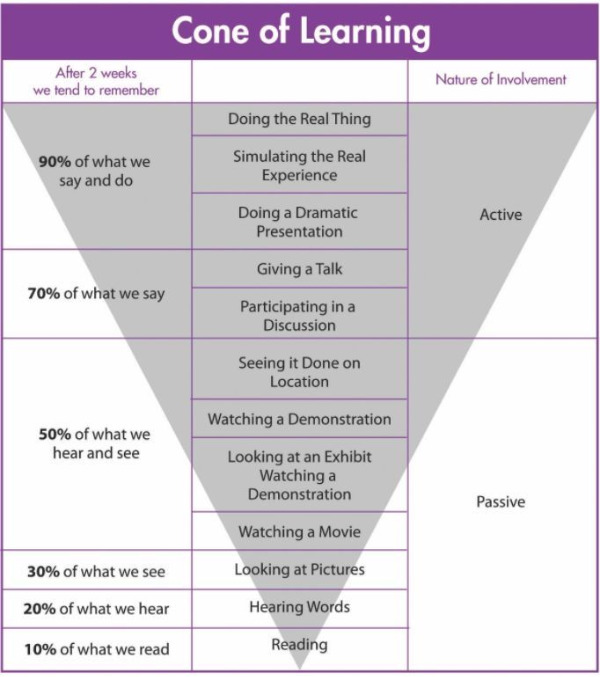Not Active Versus Passive
There is no shortage of models of learning. If you study pedagogy, you learn about Behaviorism (Pavlov), Cognitivism (Paget), Meaningful Learning Theory (Ausubel), Social Learning Theory (Bandura), Social Constructivism (Vygotsky) and Multiple Intelligences (Gardner) - and that list in incomplete.
There are also a good number of visual representations of learning that appear as a pyramid, steps, roadmap or the cone shown here.

The Cone of Learning shown here is based on the theory that true "learning" means that we remember what was learned. But looking at it, you would say that reading is a method from which little is retained or learned. If you tested me on a book I read last year, I would probably fail. And yet, I would maintain that what I do remember may well be the most important learning that I personally needed from the book.
Many interpretations of this model of learning would stress that after reading moving up the cone to talk about the reading and giving a presentation about it would make the content far better learned. Personally, it is true that the novels I know best are those I have taught to others.
This movement up the cone of learning can be viewed as moving from passive to active learning.
Passive learning is broadly defined as a method of learning or instruction where students receive information from the instructor and internalize it. Without much or any feedback from the instructor or source of information, this learning may require memorization, rote learning, direct instruction and lecture. Passive learning is frequently passive listening. It is often teacher-centered.
Criticism of passive listening has been strong saying that students retain information only until they are assessed and the learning does not stay with them. Active learning is promoted as a teaching method aimed at solving this problem.
Unfortunately, sometimes passive learning is seen as bad while active is good. It becomes active versus passive when really one doesn't really succeed without the other.
In looking at the advantages of passive learning, you would include how it exposes us to new material. It gives a teacher greater control over the students. It can be and should be prepared in advance via lecture notes, handouts, audiovisual media and the concepts and content can be organized and structured in a meaningful manner;. It is effective for large audiences.
Passive learning dangerously needs to make the assumption that students will receive the subject matter with open minds. They can be - also dangerously - as empty vessels that need to be filled with a dump of knowledge, or that they are dry sponges hungry to absorb the learning.
It can be difficult to assess how well students are learning content. What would be a passive way to confirm learning from a student who has read a chapter? A test? Ineffective. Repeating or remembering information without reflecting or demonstrating an understanding seems like a poor model of learning.
Nigel Nisbet describes the differences between active learning and passive learning to an audience of school superintendents.
Active learning is defined in different ways:
"anything that involves students in doing things and thinking about the things they are doing" (Bonwell & Eison, 1991)
"anything course-related that all students in a class session are called upon to do other than simply watching, listening and taking notes" (Felder & Brent, 2009).
Active learning strategies can be mixed with passive activities. Activities can be as short as a few minutes that are integrated into a lecture. Reading and writing can be passive but when combined with discussion, problem solving, or cooperative learning they can become active.
Active learning puts the responsibility on both the teacher and the students. Teachers using an active learning style are responsible for knowing the subject they teach, but also the best methods of assessing, starting discussions and providing activities for reflection and continued learning outside of class. Students need to be prepared to discuss each day’s topic, write down their thoughts on the subject, participate in group study outside of class, and work cooperatively inside and outside of the classroom.
Most assessment in passive learning is fairly strict with one right answer, while in active learning there is more flexibility. As shown on the cone diagram, passively watch a film might be evaluated with a test or essay assignment - also passive. Evaluating the understanding of reading about the Golden Ratio and Fibonacci numbers in a math class might be evaluated with an outdoors search for the ratio in nature.
Neither passive nor active is best. Active learning requires some passive learning. As Benjamin Bloom showed, knowledge is a basis for higher-level thinking. That might be the learning in primary grades or the 101 level course in college. The danger is learning that is all passive with any higher-level and active learning experiences. It is also dangerous to leap to active learning without a foundation of knowledge and the ability of students to learn on-their-own passively sometimes.
Trackbacks
Trackback specific URI for this entryThe author does not allow comments to this entry
Comments
No comments